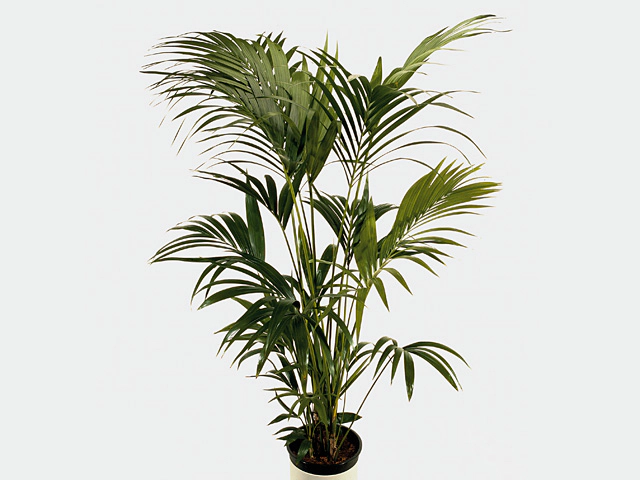Howea forsteriana

| Leaf tip | Pointed/acute |
| Fruit type | Berry |
| Flower scent | Unscented |
| Leaf type | Foliage leaf |
| Leaf, general shape | Elongate |
| Plant height | 1,2 - 1,4 m |
| Inflorescence | Raceme |
| Leaf surface | Glossy |
| Leaf size | 40 - 50 cm |
| Leaf division | Pinnate |
| Plant, growth type | Erect |
The Kentia Palm, scientifically known as Howea forsteriana, is a popular plant that adds a touch of elegance to any space. This beautiful palm is native to the Lord Howe Island located in the Tasman Sea, between Australia and New Zealand. It has gained popularity as a houseplant due to its adaptability to different indoor conditions and low maintenance requirements.
One of the distinctive features of the Kentia Palm is its pointed or acute leaf tip. The leaves are elongate in shape, with a glossy surface that adds a touch of sophistication to its overall appearance. The leaf size ranges between 40 to 50 centimeters, making it a perfect choice for those looking for a statement piece.
The Kentia Palm is characterized by its pinnate leaf division, wherein the leaflets are arranged in a feather-like pattern along the central stalk. This type of leaf division enhances the plant's aesthetic appeal, giving it a lush and tropical look. The plant's growth type is erect, meaning it grows upward with a single trunk.
Although its inflorescence, known as a raceme, is not particularly showy, the Kentia Palm produces small, unscented flowers that eventually give way to small berries. These berries, although not edible, add a touch of visual interest to the overall look of the plant.
The Kentia Palm is a moderate-sized plant, reaching a height of about 1.2 to 1.4 meters. This makes it a suitable choice for both indoor and outdoor settings. Its adaptability to different light conditions, including full sun or partial shade, allows it to thrive in various environments.
In terms of care, the Kentia Palm is considered a low maintenance plant. It prefers a well-draining potting mix and should be watered regularly but sparingly, allowing the top layer of soil to dry out between waterings. Over-watering can lead to root rot, so it's important to strike a balance. Additionally, the palm benefits from occasional misting to enhance humidity levels, especially in dry indoor environments.
As with any houseplant, the Kentia Palm can benefit from regular fertilization to ensure healthy growth. Using a balanced houseplant fertilizer once a month during the growing season will provide the necessary nutrients for optimal growth.
Overall, the Kentia Palm is a versatile and visually appealing plant that can enhance any space with its lush green foliage. Its low maintenance requirements and adaptability make it a popular choice for both experienced and novice plant owners. Whether placed in a living room, office, or garden, the Kentia Palm is sure to provide a touch of tropical elegance that will be appreciated by all.
Market availability index by month:
| Jan. | Feb. | Mar. | Apr. | May | Jun. | Jul. | Aug. | Sep. | Oct. | Nov. | Dec. |
|---|---|---|---|---|---|---|---|---|---|---|---|
| 4 | 3 | 3 | 3 | 3 | 3 | 2 | 3 | 3 | 3 | 3 | 3 |